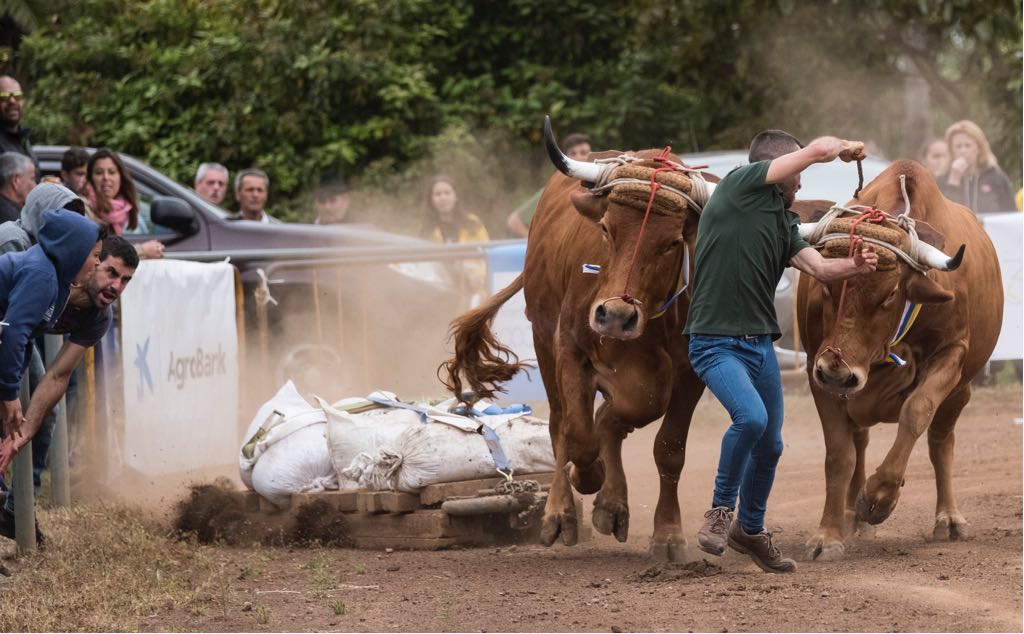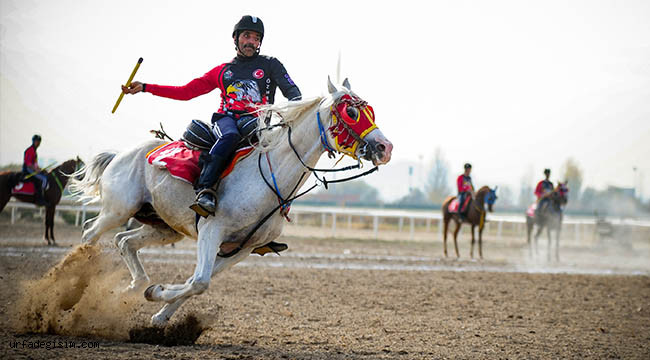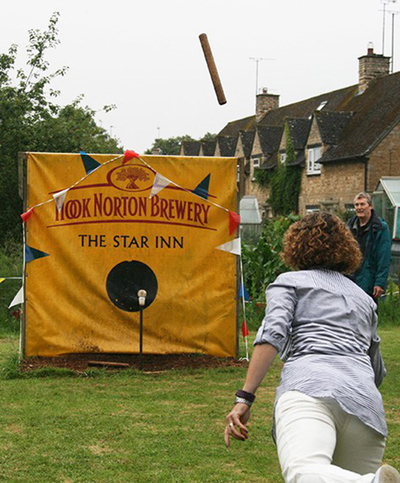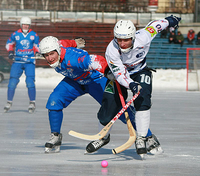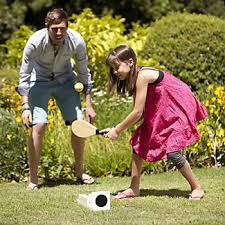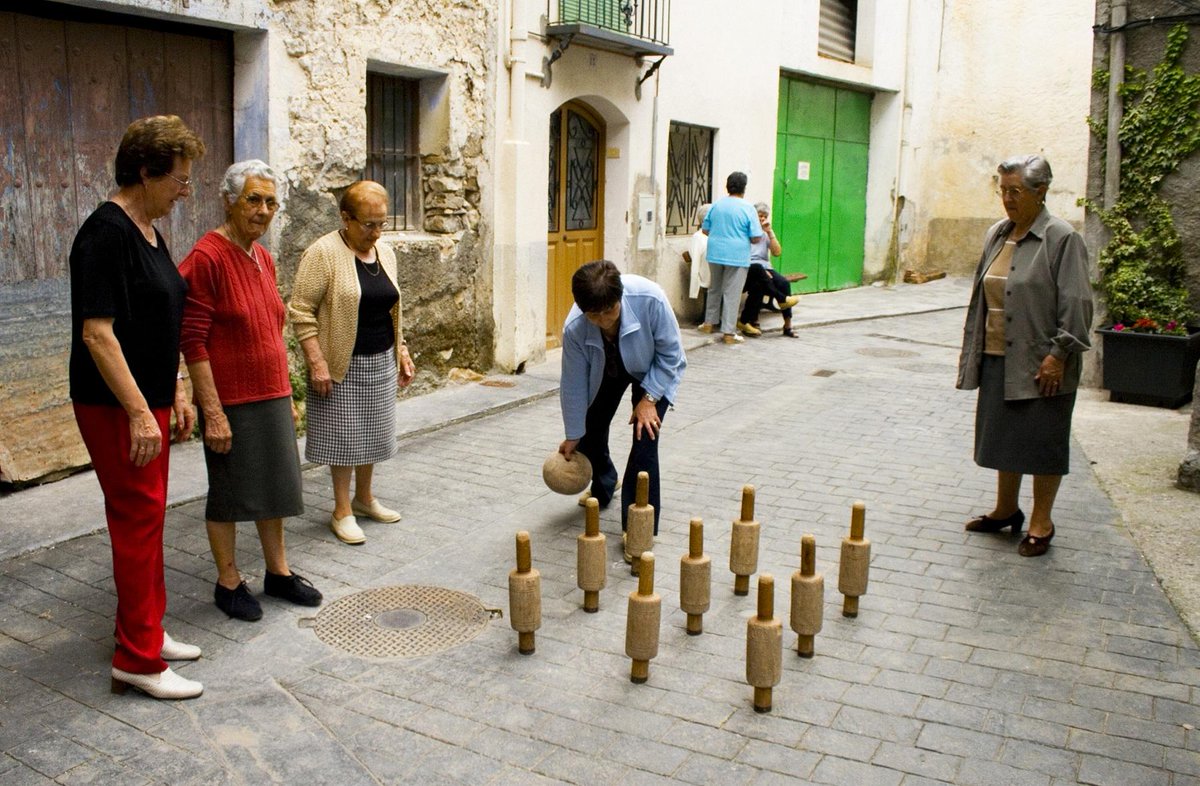- Name of sport (game): Aluche cántabro
- Place of practice (continent, state, nation):
Spain
- Name of sport (game): Ankoumara
- Place of practice (continent, state, nation):
Georgia
- Name of sport (game): Arrastre de Ganado
- Name in native language: Arrastre de Ganado
- Place of practice (continent, state, nation):
Canary Islands
- History:
El arrastre de ganado has been practiced throughout the Archipelago, mainly on the islands of La Palma, Tenerife and Gran Canaria, using cows and oxen for this.
The practice of this sport or exercise is subject to livestock fairs and popular celebrations, where the farmer exhibits the "Coarse" cattle to which he has devoted so much money and care for their breeding and conservation.
Regarding the origin of the Canary ox, there have been some studies that affirm that this animal has adapted to the climate of the Canary Islands, and that it is far from the peninsular breed and the English breeds.
These animals have traditionally been used to plow, thresh and drag weight, but nowadays due to the abandonment of the agricultural activity and the incorporation of new technologies such as the widespread use of the tractor, the ox has moved towards the stables.
There are two varieties of this animals:
Canaria, Creole or Basta: it probably to come from the Galician and Asturian blonde races, which were brought to the Islands after the Spanish Conquest. After several centuries of mixing, it can be considered as an indigenous breed.
The weight of the animal ranges from 600 to 700 kilograms.
Palmera: it is quite likely that it comes from the rubia gallega. It is generally located in the North of the Island. The cows weigh around 600 kilograms and the bulls over 800 kilograms. Them color ranges from dirty white to yellowish. - Description:
The Tools
Corsa: Grau Bassas described it as an instrument destined to carry large weights that a team drags on the ground. It consists of two thick timbers joined at an acute angle and reinforced with strong crossbars. The wood used is usually usually Eucalyptus (Eucaliptus globulus), since it is quite common to find the branches of this tree in the form of a fork. They are also made of cypress wood and walnut (Chlorophora tinctoria Gaud, Syn), although the latter are more difficult to find unlike eucalyptus.
Yugo: it is another of the elements used in the drag. It is built as a general rule from resistant woods since it is one of the points where the forces are most exposed when making the shot.
Frontiles: it is a way to tie the load on the animal.
Coyunda: strap or rope to hold the yoke to the cows' head.
Vara: goad that the farmer carries to warn the animal.
In Gran Canaria, el arrastre de ganado has a great repercussion, in turn, it bears a lot of resemblance to the dragging of cattle practiced in the Basque Country, where stones are dragged as far as possible, but on Canary Island it remained as a testimony.
The land where cattle trawling is practiced is rectangular, about 50 meters long by 15 meters wide, the limits being indicated by lines.
The drag test is carried out against the clock, having a maximum drag time of 4 minutes, the drag is guided by the figure of the Boyero or Guayero, using a stick provided by the organization.
Control of the test is carried out by three judges, one on the field, one on the table and one who controls the weight of the drag.
Cows can carry a maximum of 800 kilograms and a minimum of 600 kilograms, while bulls have a maximum allowed of 1100 kilograms and a minimum of 800. - Current status:
Practiced
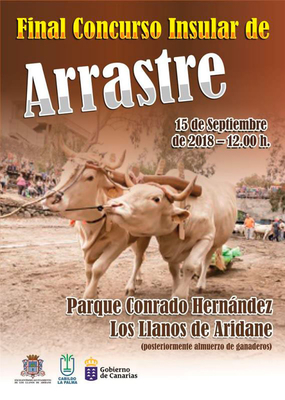

- Contacts:
Federación de Arrastre Canario
Webside: https://federacion-de-arrastre-canario.webnode.es/
Tel. +34 922 26 31 89
E-mail:This email address is being protected from spambots. You need JavaScript enabled to view it. 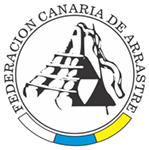
- Sources of information :
Source of photos used in this article:
https://diariodeavisos.elespanol.com/2020/07/el-arrastre-de-ganado-vuelve-a-la-actividad-con-todas-las-garantias/
https://www.isladetenerifevivela.com/2012/12/arrastre-de-ganado-juegos-tradicionales.html
https://diariodeavisos.elespanol.com/2017/04/arrastre-ganado-vuelve-domingo-la-finca-los-zamorano-tegueste/
http://www.diariodetenerife.info/el-cabildo-organiza-para-este-domingo-un-arrastre-de-ganado-en-la-casa-de-carta/
http://www.elbaifoilustrado.com/tag/arrastre-de-ganado/
https://www3.gobiernodecanarias.org/noticias/tag/arrastre-de-ganado/
https://www.flickr.com/photos/victor-pacheco/31541639133
https://www.infotegueste.com/2021/05/13/concurso-de-arrastre-de-ganado-cabildo-insular-de-tenerife/ - Gallery:
- Name of sport (game): Asparezoba
- Name in native language: Asparezoba
- Place of practice (continent, state, nation):
Georgia
- Description:
Horse riding and horse-related games
- Name of sport (game): Cirit or jareed
- Name in native language: Cirit or çavgan
- Place of practice (continent, state, nation):
Turkey. Regularly practiced in the provinces of Konya and Balikesir (red). Practiced sporadically, during special occasions (such as the veterans' feast on the second Sunday of September) in the provinces of Erzrum, Kars, Bayburt, Bilecik (orange).
- History:
Cirit is an equestrian sport. It is attended by two teams whose members aim is to hit opponents with blunt javelins.
This sport is an achievement of the traditions of the Turkish commons. They were nomads living in Central and Eastern Asia since antiquity. Because they spent entire lives on horses, all aspects of their lives (including sport) were associated with these animals. The sports that are their cultural heritage include, among others, cirit and buzkashi, i.e. the national equestrian sport of the Tajik and Uzbeks, which involves ripping the corpse of a goat.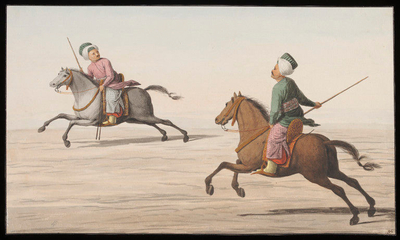
Over the years, the Turkish people moved more and more to the west. In the 11th century AD, the Seljuk Turks came to Anatolia, where they settled after the repulsion of Byzantium. Together with them, their traditions took root in the region, and already at that time cirit was practiced. After the fall of the Seljuks, Turkey was confederated by the Ottomans in the 14th century. Their empire have survived until the 20th century and cover the lands from the Balkans to Egypt. During their reign, cirit was extremely popular. It was adopted as a courtly sport, to the extent that it was practiced by sultans Bajazyd I and Mehmed I. The peak of popularity fell on the 16th century when cirit was established as part of military exercises for cavalrymen to improve attack and defense skills. This decision was made because this sport prepared both the rider and the horse for military operations.
Unfortunately, in the 19th century, Sultan Mahmud II banned cirit practice because he considered it too dangerous. After the ban, cirit disappeared from the courts of the aristocracy but continued to develop in the provinces. Another decrease of the popularity of this sport was the dissolution of the Ottoman Empire in 1922 and the modernization of the state. In the following years, this sport was losing its popularity and to this day it has remained only in a few provinces, although it is practiced on important occasions in different parts of Turkey. The first sports club was founded in 1957 in Erzrum. In 1996, the Traditional Sports Federation of Turkey was founded to promote, among others, cirit. In 2007, a Turkish film was made in which the main characters practice cirit – The White Angel (2007).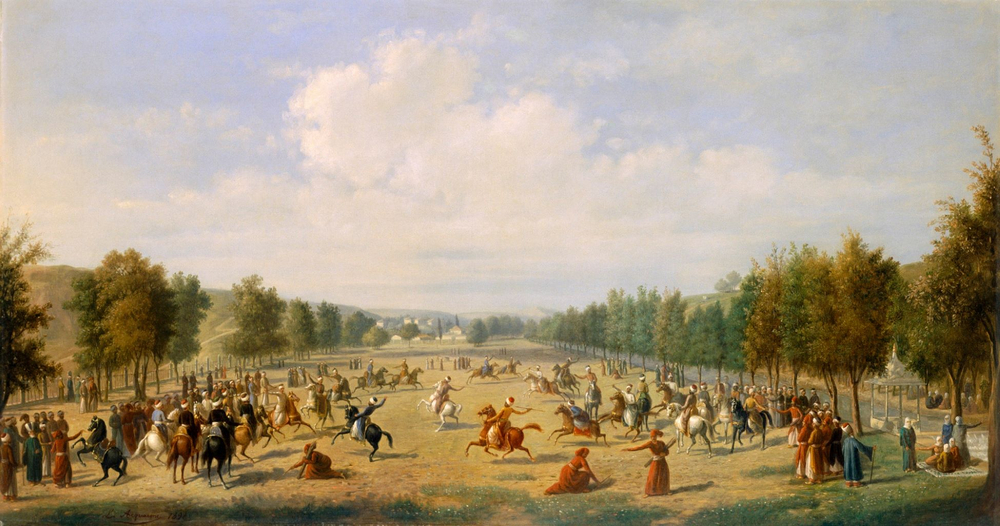
Luigi Acquarone- Cirit game in Kağıthane – 1891
(Source: https://blog.peramuzesi.org.tr/en/haftanin-eseri/kagithanede-cirit/) - Description:
There are two teams, each contains of 6, 8 or 12 players participating in the game, each on horseback. Horses must be endured, fast and smart. The Arabian race is often used in the game, but there is also a specially cirit breed race for this purpose after the crossing of the Arabian race with the Anadol horse. Players, depending on the occasion, can be dressed in traditional decorations, referring to elite Ottoman cavalrymen - spahis.
The pitch should be 70 to 130 meters long (for comparison, a football field is 105 meters long). The last 6 meters of each side is separated as a zone in which the player has immunity and no one can throw at him.
The game begins with the welcome of both teams in the middle of the pitch. Then, if the game takes place in front of the audience, there is a parade with the accompaniment with military or folk music. Such music is usually played with typical Turkish instrument like a drum (davul, tapan, atabal or tabl) and zurna (Turkish trumpet). Before starting the game, the pavement quality is checked by driving around the field. Players return to their team's side.
Later, riders test the field and their horses, than go back to their section. Sometimes players wear traditional regional costumes, as a symbol of the Sipahis (Ottoman cavalrymen). The teams line up facing one another on the field, each player at a distance of about 10 meters from the next. With the right hand, they hold the first cirit javelin that they will throw while those who wait for their turn hold cirit javelin in the left hand.
The whole game is observed by referees, they also check that all equipment is properly used. Every player and horse have the number to identify them, moreover, in official games, riders wear a special helmet to protect the head from injury and horses have a saddle.
Kolbaşı is the leader of the team, he is responsible for tactics and for making substitutions, every team has additional players but during the game, the team is allowed to do maximum three substitutions. Any decision must be delivered to the referees and accept by them before it is done.
Each team have their own safe zone which is located at the end of one side of the field, in front of this zone is a second zone wide about 5 meters where the running rider must enter just before summoning and throwing a javelin
The game starts when the first player sets off from the safe area towards the other team, approaching it for about 30 meters in the second zone. He summons an enemy by shouting the player’s name, throws a javelin at him and rushes towards own team. The summoned player begins the pursuit, whose ultimate goal is to get close enough to be able to hit the enemy with his javelin. When the escapee is in a safe zone, one of his teammates goes out to meet the pursuer. The pursuer turns his horse back and rushes to escape. The rest of the game goes in this cycle, each player chases first, then is being chased. The game lasts 80 minutes, with one break.
Points are earned for hitting an opponent or catching his javelin. Negative points are awarded for throwing a javelin in a safe area, for throwing a javelin at a distance of less than 5 meters, and for hitting a horse instead of a rider. Some sources even say that hitting a horse means disqualification.
Players have at their disposal numerous defensive manoeuvres. They can hang from the side of the horse so that it covers them from the javelin, or take shelter under his trunk. The game develops riding skills, the ability to accurately throw the javelin, and the ability to predict the trajectory of javelin flight. The formation of the two teams has its traditional etiquette. Care is taken not to put players, who are on bad terms in opposing teams, and players, who display deliberately hostile behaviour during a match are blacklisted.
There are injuries in the game. If you hit the eye, fall off a horse, or be trampled by amount, injuries can even lead to death. A player killed during the game becomes a local martyr, and the family of the deceased does not generally accuse the opposing team in court. Therefore, if there are any known hostilities amongst players they can be left out of the tournament or put in the same team by the elder people of the locality, or by the referees before the game starts
At the end of the game, the winner is announced by a council of former cirit players depending on points collected by two teams. Organizers give awards to the winning team and prepare big meals.
Equipment:
- Not a very large horse, older than 4 years. Popular breeds are Cirit and Arabian horses.
- Several cirit javelins with rubber coated tips. They are 70-100 cm long, 2-3 cm in diameter. Formerly they were made of dactyl or oak wood. Poplar wood is currently preferred because of its lightness, which minimizes the likelihood of injury.
- Sometimes helmets are used to protect against javelin or falls from a horse.
- The outfit depends on the occasion. Common sportswear is often enough, but on official occasions both the rider and the horse must wear exquisite clothes.
Vocabulary:
-Alan - cirit pitch.
-Değnek, Diğnek or Deynek (stick) - The name given to cirit in some regions.
-Acemi - a rookie; nickname for the player who hits the horse with a javelin.
-Atbaşı (head-to-head) - The situation that two horses running in the same line.
-At cambazı - an extraordinary rider.
-Şehit - martyr; player who died during the game.
-Dörtnal (gallop) - Fastest gait of the horse.
- Meydan - Flat ground field for playing jereed game.
- Alay basmak - Penetrating into opponent's line formation by losing control of own horse.
-Cirit havası - One or all of the melodies played with drum or zurna while the cirit game is being played.
- Current status:
Cirit is still practiced in many places in Turkey. There are numerous clubs and a national league. Unfortunately, outside this country it is actually a forgotten sport. Websites are not translated into English, movies on the internet have only a few thousand views.
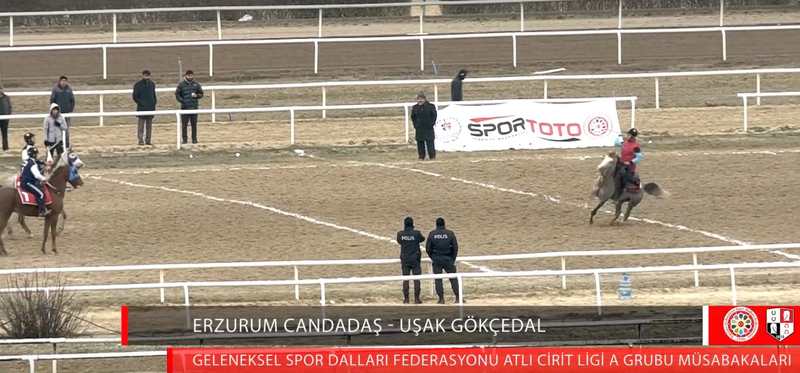
Screenshot from the recording, January 5, 2019 - Semi-final, group A competition in the Equestrian League.
(Source: https://www.youtube.com/watch?v=EqzHRKQ_Ank&index=6&list=PLdYr8KWSZHJqIX6pfzFjKnywW0pM9xIqy) - Importance (for practitioners, communities etc.):
This sport does not seem to be a very important in Turkish society, but that does not mean that it is not valuable. It is basically a fossil, a living piece of history connecting modern Turkey with its ancestors nomadic in the endless steppes of Asia.
- Contacts:
Türkiye Geleneksel Spor Dalları Federasyonu
Nasuh Akar Mahallesi,
Süleyman Hacı Abdullahoğlu Cad. 43/4 Çankaya/ Ankara
TÜRKİYE
Webside: https://www.gsdf.gov.tr/tr/haber/atli-cirit-ligi-a-grubu-musabakalari-sona-erdi
Youtube channel: https://www.youtube.com/channel/UC39BdfzhwVP-7lgnqP6S8Kw
Tel: +90 312 311 61 93
Faks :+90 312 311 90 45
E-Posta:This email address is being protected from spambots. You need JavaScript enabled to view it. 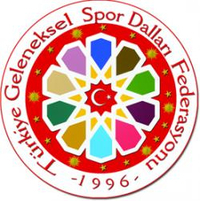
Selendi Beypınar Cirit Sevenler Kulübü
Beypınar köyü
45970 Selendi, Manisa
Tel.: +90 536 272 23 45
https://www.facebook.com/beypinarcsk/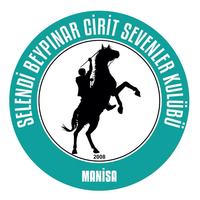
Değirmenönü atlı cirit ve okçuluk spor kulübü
https://www.facebook.com/De%C4%9Firmen%C3%B6n%C3%BC-atl%C4%B1-cirit-ve-ok%C3%A7uluk-spor-kul%C3%BCb%C3%BC-192708097990261/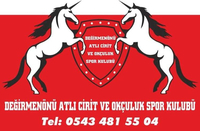
Horoz Atlı Cirit Spor Kulübü
https://www.facebook.com/pages/category/Community/Horoz-Atl%C4%B1-Cirit-Spor-Kul%C3%BCb%C3%BC-1741218752799242/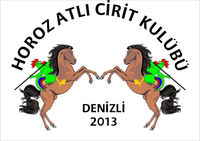
Manisa Beypınar Atlı Spor Kulübü
https://www.facebook.com/Manisa-Beyp%C4%B1nar-Atl%C4%B1-Spor-Kul%C3%BCb%C3%BC-1689509684604227/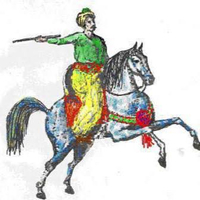
Kars Selim Çıplaklı Köyü Atlı Cirit
https://www.facebook.com/Kars-Selim-%C3%87%C4%B1plakl%C4%B1-K%C3%B6y%C3%BC-Atl%C4%B1-Cirit-264822550237241/
Tel.: 05315633220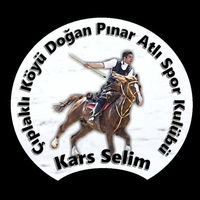
Zile Atlı Spor ve Cirit Kulübü
İSTASYON MAH
60400 Zile
Tel.: +90 532 658 09 59
https://www.facebook.com/Zile-Atl%C4%B1-Spor-ve-Cirit-Kul%C3%BCb%C3%BC-170650129654450/Uşak Akse Atlı Cirit Spor Kulübü
Tel.: 05066630592
https://www.facebook.com/akseatli/Gencosmanlı atlı cirit spor kulübü
Omurca köyü
64100 Uşak
Tel.: +90 532 622 93 98
https://www.facebook.com/Gencosmanl%C4%B1-atl%C4%B1-cirit-spor-kul%C3%BCb%C3%BC-1813942272165102/Bayburt Atlı Spor Kulübü
https://www.facebook.com/bayburtatlispor/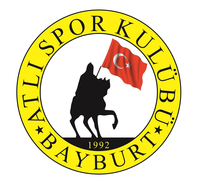
Uşak Karun Atlı Cirit Spor Kulübü Derneği
Tel.: +90 532 663 49 68
https://www.facebook.com/UsakKarunAtliCiritSporKulubuDernegi/Erzıncan Atlı Spor Kulübü
Erzincan
24000 Erzincan
Tel.: +90 543 214 85 92
https://www.facebook.com/Erz%C4%B1ncan-Atl%C4%B1-Spor-Kul%C3%BCb%C3%BC-143857025651102/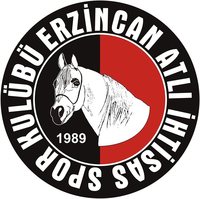
Malatya Atlı Cirit Kulübü
Fb: https://www.facebook.com/pages/category/Professional-Sports-Team/Malatya-Atl%C4%B1-Cirit-Kul%C3%BCb%C3%BC-2133123346918378/
Instagram: https://www.instagram.com/explore/locations/2133123346918378/malatya-atl-cirit-kulubu?hl=plOmurca Atli Cirit Spor Kulübü
https://www.facebook.com/pages/category/Amateur-Sports-Team/Omurca-Atli-Cirit-Spor-Kul%C3%BCb%C3%BC-547117998748118/Malatya Yazıhan Atlı Binicilik Safari Okçuluk ve Cirit Kulübü
Malatya Yazıhan
44350 Malatya
Tel.: +90 552 414 95 60
https://www.facebook.com/safariatmalatya/ - Sources of information :
Articles:
http://www.turkishculture.org/lifestyles/turkish-culture-portal/cirit-231.htm
https://blog.peramuzesi.org.tr/en/haftanin-eseri/kagithanede-cirit/
http://www.kultur.gov.tr/EN-98587/the-game-of-jereed.html
https://www.allaboutturkey.com/javelin.htmlVideo:
https://www.youtube.com/watch?v=ywSlMbCeYRQ
https://www.youtube.com/watch?v=EqzHRKQ_Ank&index=6&list=PLdYr8KWSZHJqIX6pfzFjKnywW0pM9xIqy
https://www.youtube.com/watch?v=rQbQHkKZ8L8
https://www.youtube.com/watch?v=RA5apQtAlYc&list=PLdYr8KWSZHJqIX6pfzFjKnywW0pM9xIqy&index=1Source of photos used in this article and gallery:
https://gsdf.gov.tr/tr/spor/atli-cirit
https://www.binatlisk.com/atli-cirit/
https://www.yeniakit.com.tr/haber/atli-cirit-heyacani-ankarada-surecek-633431.html
https://ajansspor.com/haber/atli-cirit-dunyaya-tanitilacak-191520
https://worldethnosport.org/etnosporlar/atli-cirit
https://www.urfadegisim.com/ata-sporu-atli-cirit-unesco-yolunda/29740/
https://www.haberler.com/spor/sivas-taki-atli-cirit-musabakalari-sona-erdi-12427119-haberi/
https://www.ogretmenlersitesi.com/ata-sporu-atli-cirit-unesco-yolunda/57200/
https://sporubenimletani.org/atli-cirit/ - Gallery:
- Documents:
- Name of sport (game): Aunt Sally
- Name in native language: Aunt Sally
- Place of practice (continent, state, nation):
Berkshire, Buckinghamshire, Gloucestershire, Oxfordshire, Northamptonshire and Warwickshire (England)
- History:
Aunt Sally is a traditional English game usually played in pub gardens and fairgrounds, in which players throw sticks or battens at a model of an old woman's head. Leagues of pub teams still play the game today, throughout the spring and summer months, mainly in Oxfordshire and some bordering counties.
In France, the game is called jeu de massacre ("game of carnage").
The game dates back to the 17th century, although the name "Aunt Sally" may have been a later addition. It was traditionally played in central English pubs and fairgrounds. An Aunt Sally was originally the modelled head of an old woman with a clay pipe in her mouth; the object was for players to throw sticks at the head in order to break the pipe.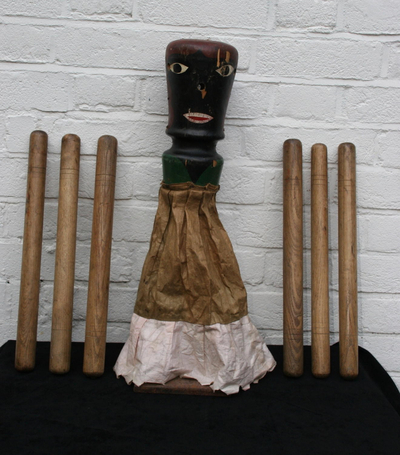
There are also other theories of how the game started. One such theory is that a live cockerel was placed on the stick, and people would throw sticks at it. Whoever killed it won the game and took home the chicken. Another theory is that in Port Meadow in Oxfordshire, at the time of the English Civil War, the Cavaliers (soldiers loyal to King Charles I) were bored and formed a game with sticks and makeshift materials similar to the game as understood today.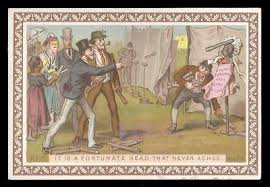
- Description:
The pitch needs to be on level ground and free from obstructions and overhanging branches. A permanent pitch will benefit from hockey to a part by iron that reduce wear on a grass area.
Some pitches are laid out on concrete or paving.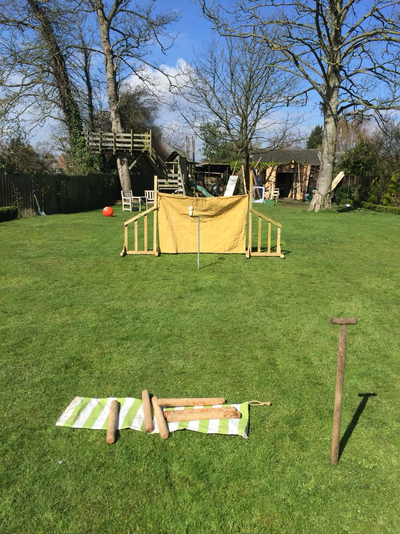
The shed at the iron needs to be well constructed/weatherproof and should be padded to reduce the energy of the sticks and hence their likelihood of rebounding. If not a shed then padding needs to be provided. Lighting is needed at both ends for late evening play and safety.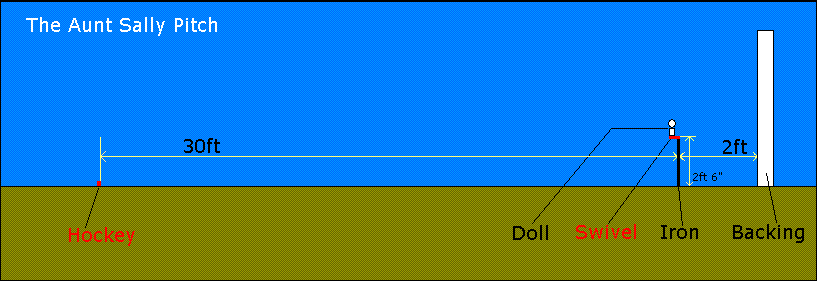
In modern Aunt Sally, the single white stubby skittle, about 6 inches high and 2 and 3/4 inches in diameter, is called "dolly" and the round-ended projectiles, of which there are six, are 18 inches long, 2 inches in diameter and are called "sticks". A hollow rod (the "iron") is driven into the earth so that the top is two and a half feet above the ground and an iron swivel is inserted into the top. The swivel can rotate and is positioned to stick out to one side with the doll set on the little platform at the swivel's end. Each turn consists of six throws, a point being is scored for each doll knocked cleanly off the swivel. Players throw the sticks at the doll from behind a line known as the "ockee" which is 10 yards from the iron.
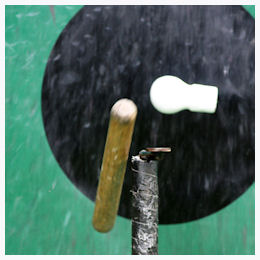
Normal league play has two teams each consisting of eight players and three legs or "horses" are played. Each horse consists of each member of each team having one turn so that each team makes 48 throws. It is believed that the record for a horse stands at 40 so it can be seen that hitting the doll is quite tricky.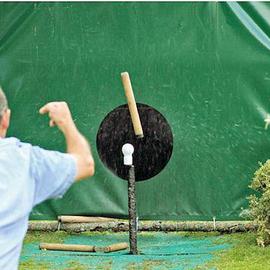
- Current status:
Today, the game of Aunt Sally is still played as a pub game in Berkshire, Buckinghamshire, Gloucestershire, Oxfordshire, Northamptonshire and Warwickshire.
Pubs from across the north Cotswolds enter teams in the Chipping Norton Invitation Aunt Sally League or the Wychwood Aunt Sally League. The Chipping Norton League was formed in the 1960s and is still going strong today. It currently supports three divisions with 23 teams and over 200 people taking part in league and cup competitions each year, with games played outdoors on summer evenings. The season runs between April and September to take advantage of the better weather.
In 2011 the inaugural Aunt Sally Singles World Championship took place at the Charlbury Beer Festival in Charlbury, West Oxfordshire. Among the attendees was prime minister David Cameron. The tournament has continued there annually ever since.
The inaugural Aunt Sally world champion in 2011 was Trevor Dyer, from Paxford, near Chipping Campden, and for the next two Record-breaking Steve Arthurs from Over Norton, who is known on the local Aunt Sally circuit as "The Legend", years another Paxford resident, Steve McAteer, carried off the trophy.
However, the 2014 championships finally saw an Oxfordshire player take the world championship title at Charlbury Cricket Club, which hosts the annual beer festival.
On 24 August 2019, the first world championship for Aunt Sally pairs was held in the Bull, Launton, Oxfordshire and was won by the pub team from The Bell, Bicester. Darren Moore and Billy Craig were the winners. Runners up were Aimee Sheehan and Christopher Hulme. - Contacts:
Chipping Norton Invitation Aunt Sally League, www.chippyauntsally.co.uk
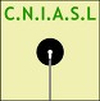
Wychwood Aunt Sally League, www.wychwood-aunt-sally-league.co.uk
Bampton Aunt Sally Association, www.bamptonauntsally.org
Oxford & District Aunt Sally Association,
Web: www.oxfordauntsally.co.uk/
Fb: https://www.facebook.com/Oxford-Aunt-Sally-199064367592241/?ref=br_rs
Greene King Oxford Aunt Sally
Results & Fixtures Secretary
10 Sandy Lane
Blackbird Leys
Oxford OX4 6AW
Home: 01865-453666
Mobile: 07786962726
Email:This email address is being protected from spambots. You need JavaScript enabled to view it. Abingdon & District Aunt Sally Association
Web: http://abingdonauntsally.com/
Fb: https://www.facebook.com/AbingdonAuntSally
Banbury & District Aunt Sally League
Web: http://www.banburyasl.16mb.com/
Email:This email address is being protected from spambots. You need JavaScript enabled to view it. 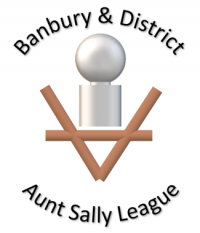
- Sources of information :
Articles:
http://www.worldwidewords.org/qa/qa-aun1.htm
https://www.tradgames.org.uk/games/Aunt-Sally.htm
https://chrispearce52.wordpress.com/2015/12/13/history-of-the-game-aunt-sally/
https://www.mastersofgames.com/rules/aunt-sally-rules.htmVideo:
https://www.youtube.com/watch?v=JAe3rWeBdEM
https://www.youtube.com/watch?v=QhPNON97CjM
https://www.youtube.com/watch?v=VXybxupIr1o - Gallery:
- Documents:
 Greene_King_Oxford__District_Aunt_Sally_League_Rules_2018.pdf
Greene_King_Oxford__District_Aunt_Sally_League_Rules_2018.pdf
- Name of sport (game): Backhold (Back-hold)
- Place of practice (continent, state, nation):
Scotland (Alba)
- Description:
Back-Hold is the wrestling style practised in the Highland games. Back-Hold is played on grass, outdoor. Every body can inter the competition.
It is a standing up wrestling style with clothes. The wrestlers (men or women) wear a T-Shirt and a kilt. Legs can grip legs and the arm position is fixed. There are several weight and age categories. Techniques are mainly with hips and legs and the goal is to throw the opponent on any part of the body.
- Name of sport (game): Bandy
- Name in native language: Bandy
- Place of practice (continent, state, nation):
Finland, Kazakhstan, Russia, Sweden, Germany, Norway, USA, Canada, China, Czech Republic, Estonia, Great Britain, Hungary, Japan, Latvia, Slovakia, Somalia, Switzerland, Ukraine, Belarus, Kyrgyzstan, Mongolia, The Netherlands, Lithuania, Afghanistan, Armenia, Colombia, India and more.
- History:
Source: https://www.bandyinolympics.com/history/
As most ancient and medieval evidence hockey refers to curved shaped sticks and a ball, bandy can claim to be the oldest team hockey sport on ice.
Skates made of animal shack bones 2000 BC and irrigated ponds are found in Hungary, although yet no final proof of ball hockey on ice using skates. Most concrete evidence suggests ball hockey on plains or frozen ponds without skates.
Historians suggest that the oldest branch of ball-sports is hockey sports. The ball and a curved stick describe them. Curved shaped crooks (the shepherds crook) were used as a stick. In summer time it was played on plains, and wintertime on frozen ponds. Bandy’s twin summer sports hockey (FIH), Ireland’s hurley, Scotland’s shintey, and Wales’ bando can in a way claim to be the oldest team sports. This is based on e.g. the mural illustration of ball hockey found in excavations in Egypt originating 2600 BC.
Unlike in ancient Greece, the most common ancient Chinese sports were ball games. Buda (field hockey) was played in the Tang dynasty (618-907 AD). Buda later developed into Chinese golf. The Daur people in the north played Beikuo (field hockey) for 1000 years. In 2004 FIFA recognized that football originates from China. Cuju (soccer) appeared in the Warring State period (476-221 BC) to the Ming Dynasty (1368-1644 AD). The inflatable ball was invented 200 AD. This innovation is probably the greatest sports innovation in history.
Football on ice emerges in China. When the 2000-year-old cuju (soccer) faded, the Manchurians in the north created football on the ice. This was during the Manchurian Qing Dynasty (1644-1912 AD). But cuju on ice appears to be without a stick. In North Asia, bandy is the main winter heritage sport.
Evidence suggests that ball hockey on the ice was played without skates, or by using simple skates made of animal shack bones. Indigenous tribes in North America played with curved sticks. They pressed the stick into a curved shape using animal sinew. It was considered cheating keeping the sinews on the stick. According to the legend, this was the start of lacrosse. The Vikings on Iceland (Knattleikur) played ball hockey with curved sticks. 1st evidence of ball hockey skates appears to be 1000 AD found in Russian monasteries.
Joseph Strutt’s book from 1801: Sports and Pastimes describe a game called bandy appear on the British Isles from 14c.
West Europe, particularly the British Isles, would later develop ball hockey on modern skates, which today is known as bandy. Interchangeably, depending on the Isles’ geographic area, it was called hockey on ice, hurley on the ice, shintey on ice or simply bandy.
Many sports got their modern rules codified in the era of the British Empire. The same applies to bandy. Evidence from Cambridgeshire in England suggests formal competition bandy from the mid 18c. No written codes are found, but historians suggest that there were standard rules agreed upon prior to each competition. With regular bandy matches from 18c, bandy can demonstrate coherent sport-competitions for at least 250 years.
During 19c, bandy was played between bandy clubs like Bury Fen, Virginia Waters, Winchester, and Northampton. Well-known football clubs like Sheffield United (1855) and Nottingham Forest (1865) even had bandy in their names. Oxford University claims that the 1st Varsity Match held 1885 in St Moritz between the Oxford and Cambridge University was with bandy rules.
Charles Goodman Tebbutt from Bluntisham in the Fens codified modern bandy rules. He came from the bandy stronghold in Cambridgeshire, England in 1891/92. Tebbutt campaigned successfully and European nations adopted the rules. In 1891 Tebutt’s club, Bury Fen played a team from Haarlem in the Netherlands. Following this, the Amsterdamsche Hockey en Bandy Club (AH&BC) was established 1892 and the Netherlandsche Hockey en Bandy Bond 1898. Four Dutch (field) hockey clubs still keep bandy in their official name e.g. Breda Hockey en Bandy Club (BH&BC) established 1905.
Prior the Great War eight continental European nations competed in European Championships up until 1913 in Switzerland. In parallel, the Nordic countries participated in the Nordic Games.
At the same time, Canadians rules hockey emerged in North America. Governor General of Canada, Frederick Stanley commissioned the famous trophy 1892. The USA joined Canadian Rules hockey but had back in history played ball hockey. Simplified one can say there was Canadian rules hockey in North America and Anglo-Russian rules hockey (bandy) in Europe and the Asian part of the Russian Empire (later USSR). As mentioned, both sports (confusingly today) used the official name ice hockey.
Canadian hockey was well organized and established the International Ice Hockey Federation (IIHF) 1908. The IIHF managed to get a bridgehead in the Summer Olympic in Antwerpen 1920. Antwerpen had a small sheet ice venue.
Bandy was part of the Winter Olympic precursor The Nordic Games 1901 – 1926. But it is fair to say that international bandy was not as well organized internationally compared to that of ice hockey.
Subsequent the IOC decision 1924 to not include bandy in the Chamonix Games, the Nordic national ice hockey federations changed their official name to bandy. USSR however, kept the name hockey with the ball. More importantly bandy lost entire nations and its players to ice hockey.
Bandy has a strong history and tradition. The IOC decision in 1924 to exclude bandy was influenced by the rivalry between Sweden and the IOC. Outside the aegis of the IOC, bandy was surprisingly strong until the late 1960s. It was not only a large winter sport but among the larger of all sports in the USSR and the Nordics. In terms of nations it, however, lost ground in continental Europe 1924-1971. It lost continental European nations and its players to ice hockey. Facing the overwhelming resources of the IOC bandy was bent, but not beaten. These new ice hockey nations (based on bandy tradition), with the exception of Czechoslovakia, could not match the North Americans. Thanks to affordable ice and synergies with bandy, the Nordic countries, and the USSR/Russia were the only nations that could challenge the Americans in ice hockey. Thanks to bandy.
Norway accelerated bandy as an Olympic demonstration sport up to 1952. The backdrop gives insight into the rationale. The USSR joined the IOC 1949. No other winter sport could better reinforce the objectives of Olympism.
The winter sports universe was (and is) small compared to summer sports. Exception was bandy. In the 1950s and 1960s, bandy was among the largest sports in 3-4 of the 12 leading nations. This is an unusual observation in winter sports. Even more astonishing is that the IOC refused to include one of the few sports that had strong fundamental backing and could help fulfill its mandate (Olympic Principles).WORLD CHAMPIONS:1957 USSR, 1961 USSR, 1963 USSR, 1965 USSR, 1967 USSR, 1971 USSR, 1973 USSR, 1975 USSR, 1977 USSR, 1979 USSR, 1981 Sweden, 1983 Sweden, 1985 USSR, 1987 Sweden, 1989 USSR, 1991 USSR, 1993 Sweden, 1995 Sweden, 1997 Sweden, 1999 Russia.
WORLD CUP CHAMPIONS: 1974 Sandviken (Swe), 1975 Broberg (Swe), 1976 OLS Oulu (Fin), 1977 Broberg (Swe), 1978 Broberg (Swe), 1979 Edsbyn (Swe), 1980 Boltic (Swe), 1981 Boltic (Swe), 1982 Jenisej (USSR), 1983 Broberg (Swe), 1984 Jenisej (USSR), 1985 Boltic (Swe), 1986 Boltic (Swe), 1987 Västerås (Swe), 1988 Vetlanda (Swe), 1989 Västerås (Swe), 1990 Zorkij (Rus), 1991 Edsbyn (Swe), 1992 Sirius (Swe), 1993 Vetlanda (Swe), 1994 Västerås (Swe), 1995 Boltic (Swe), 1996 Boltic (Swe), 1997 Västerås (Swe), 1998 Falun (Swe), 1999 Hammarby (Swe).
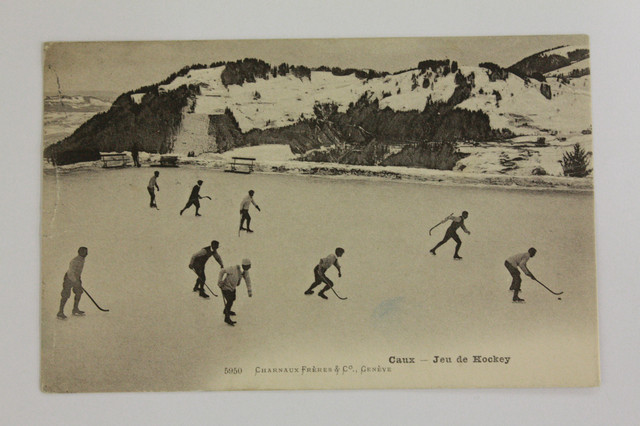 Antique Bandy Shinty Game - Caux-Jeu de Hockey - 1906 - Geneve - Switzerland
Antique Bandy Shinty Game - Caux-Jeu de Hockey - 1906 - Geneve - Switzerland - Description:
Source: https://www.bandyinolympics.com/rules/
Light Installations On Existing Venue
Bandy use existing ball-sport venues. The playing field is spooled with ice. Therefore it can easily be included in the Games for little cost. The standard ice surface used is about 100 by 60 meters, but flexible rules allow for sideline length between 110 – 90 meters and deadline width between 45 – 65 meters. The sidelines are hedged by 15 cm high light demountable low-borders. The demountable low-borders and goals are not fixed, but give in at impact, for safety.
The goal-post height is 2,1 meter and crossbar width 3,5 meter. The ball diameter is 63 mm with a weight of 60 g. The large goal compared to the small ball give bandy goaltenders a greater challenge, but also an opportunity for agile artistry. The speed of the ball and the speed of the opposing team’s forwards ( and light protection) makes the goaltender generally respected for his or her courage.Source: https://www.tutorialspoint.com/bandy/bandy_rules.htm
There are 18 official rules which are applied in all styles of bandy. However, there are slight modifications for women, juniors, and veterans.Players and Officials
Each team consists of a maximum of 11 players (not counting substitutes). Among them one is the goalkeeper. A team is not eligible to play if it has less than eight players.
It is allowed for the goalkeepers to touch the ball with their bare arms but only inside the penalty area present in front of the goal post. Out of many possible outfield positions, players (except the goalkeeper) are positioned according to their coach’s advice.
Players can be replaced by substitutes at anytime during the course of the game. Substitutions can be done without notifying the referee and can be performed while the ball is in the match. However, if the substitute enters the field before his teammate has left it, it results in a five-minute ban.
A team can bring up to four substitutes into the game and one of these is mostly a substitute goalkeeper. The game is officiated by a referee, the authority and enforcer of the rules, whose decisions are final. There may be one or two assistant referees along with the main referee.Bandy − Equipment
The players are equipped with a pair of skates, a helmet, a mouth guard. Besides these, goalkeeper also has to wear a face guard. Both the teams should wear uniforms which are easily distinguishable and the color of the skates, sticks, and any tapes etc. must be different than that of the ball.
In addition to the above mentioned equipment, various protections are used to protect the essential parts of the body like knees, elbows, genitals and throat. Paddings are given in pants and gloves to provide extra protection.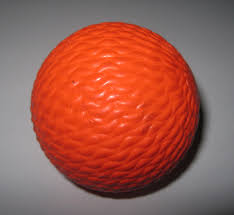
The Bandy Stick
The bandy stick is a very essential part of the sport. The stick should be built of good quality wood and must not contain any metal and sharp materials which can hurt other surrounding players.
This stick should be crooked and the bend of the blade has to be split up into five different dimensions, where one is the smallest bend and five is the largest. Bend number four is the most common size in professional bandy.
The bandy stick should not have similar colors to the ball, such as orange or pink. It should not be longer than 127cm (50 inches) and the breadth should not exceed 7cm (2.8 inches).Game duration and tie breaking measures
Bandy match can be played in two halves, each of 45 minutes duration. If every half of the match goes on smoothly and continuously without any abruption, then it means the clock is not stopped but it is under the control of referee to pause the match.
There is usually a 15-minute half-time break between halves. The end of the match is known as full-time. The referee keeps track of the time and he is the one who may make an allowance for time lost while substitutions, in case a player gets injured, or any other stoppages.
If the weather is too cold or unfavorable, the referee can break the match into shorter thirds or quarters instead of 45 minute halves. For example, in the extremely cold 1999 World Championship, a few of the matches had to be played in four quarters of 15 minutes each along with extra-long breaks in between the quarters.
If the game ends in a draw, the time may be increased to further 15 minute periods for the match. If there’s a goal in this extra time, it is called a golden goal which results in the victory of team which scored the goal. If both the extra periods are over without any goals, then the referee has to organize a penalty shootout to finally end the game.
Although, in league competitions, if there is a draw, there is no increase in time and the game is set to tie with no winner.The ball in and out of play
If the match is going on and the ball is in the field, it is said to be ball in play. When the ball gets out of the field by one way or another, it is said to be ball out of play. These are the two basic phases of the game.
When the ball is out of play, six popular methods to resume the match are −
Face-off
Goal-throw
Free-stroke
Corner-stroke
Penalty shot
Stroke-off
Suppose the time runs out when a free stroke or penalty has to be executed, the player can still strike the ball but it must go into the goal without any interference in one try, or else there are no more retries and the game has to come to an end.Penalty shots and free strokes
Free strokes are awarded to a team in case the opposite team do any fault by not obeying the rule. Take an instance, where a player hits the opponent’s stick with his own stick, it is case of fault hence free strokes will be awarded.
Free-strokes can also be awarded if there is any incorrect execution of corner strikes, free-strikes, goal throws, and so on, or the use of incorrect equipment, like using a broken stick.
There may be such instance that if your team is doing in any offence and it is benefiting the other team, and then referee may continue the play as penalty, popularly known as playing an advantage. If no such situation is happening then referee may call back and penalize the offending team.
Let’s analyse another case. Suppose you are a defender and you attacked one of the other team members while defending, then that team will get a penalty shot in reward, provided there is a chance of goal.
No one except the goalkeeper has the advantage of kneeling down to block the ball and it is not in rule also for other players to block the ball with their skates or to hook the other player with it.Warnings and Penalties
Cases such as misbehaving with other players, blocking the ball, or attacking the other team members can attract penalty of 10 minutes. This is indicated by the referee by showing a blue card.
In case a player gets penalties for three times, then he can no longer play that match, as it will be a personal penalty. Another player can replace him but not before at least 5- 10 minutes of the match.
There is also a penalty for abusing the other team members or for attacking them violently. This penalty is called full game penalty. This is indicated by a red card. Once it is superimposed on a team player, he can no longer play the match and no substitute will be allowed in his place.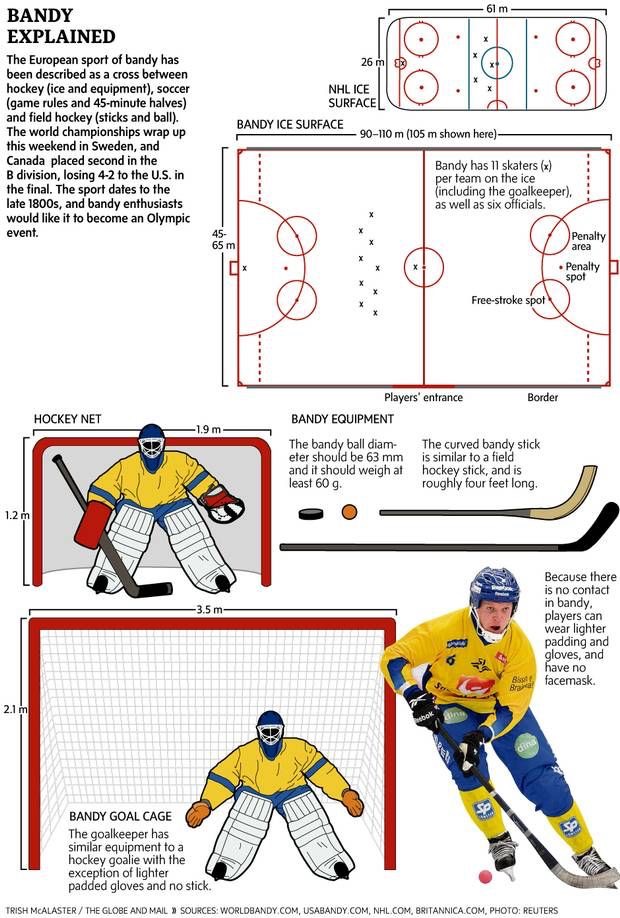
Source www.bandyinolympics.comrules
- Current status:
FIB has currently 28 member nations. Compared to many of the Olympic Disciplines, bandy has better reached the stringent 1973 Olympic Charter criteria: Real ongoing activity on 3 continents and 25 nations. This is done on own machine. And without the huge resources provided to sports in the Olympic Games.
Data reveal that many Olympic Disciplines have not reached this 45-year-old criterion. They list surprisingly many National Federation sections (NFs) that organize Disciplines at the national level. But the majority of the athletes are in very few NFs. Close to 97 % of all athletes are registered in 65 NFs (out of 1300). Ice hockey, alpine skiing, cross-country skiing, and bandy have most NFs in this size stratum. Close to 99 % are in 159 NFs. On average 10 NFs on each of the 16 Disciplines (including bandy), but they are not evenly distributed. Many Disciplines have very few NFs with real ongoing activity. Some Disciplines have in reality none.
FIB organizes 15-18 events annually. Athletes from 4 continents meet 2019. Over 30 000 active athletes, 13 years or older, compete to qualify among the 2400 quota of athletes. The major activity in bandy, as all ball sports, is still domestic within each country. Many winter Olympic Disciplines have little domestic activity. Essentially all activity is international portraying larger size than reality. The Olympic Charter requires real ongoing activity also nationally. Domestic activity is important for healthy lifestyles and a key incentive for the authorities to apply for the Winter Games.Current WCS senior qualifications alphabetically:
Division A, Men
A Pool: Finland, Kazakhstan, Russia, and Sweden. B Pool: Germany, Holland, Norway, and the USA
Division B, Men
Canada, China, Czech Republic, Estonia, Great Britain, Hungary, Japan, Latvia, Slovakia, Somalia, Switzerland, and Ukraine. Previous participants: Belarus, Kyrgyzstan, and Mongolia.
Women WCS: China, Finland, Japan, Norway, Russia, Sweden, Switzerland, and the USA. Previous participants: The Netherlands and Canada.
Lithuania has participated in youth WCS. Other members: Afghanistan, Armenia, Colombia, and India. - Contacts:
The Federation of International Bandy
c/o Bo Nyman, FIB Secretary General
Box 91
SE 826 23 Söderhamn
Sweden
Webside: http://www.worldbandy.com/
Fb: https://www.facebook.com/bandyolympics/
Instagram: https://www.instagram.com/bandyinolympics/
Twitter: https://twitter.com/bandyinolympics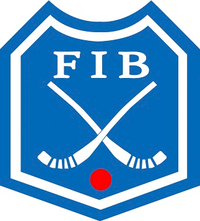
The Finnish Bandy Federation
Maapadontie 3 LT 2
00640 Helsinki
FINLAND
Deutscher Bandy-Bund e.V.
Fb: https://www.facebook.com/DeutscherBandyBund/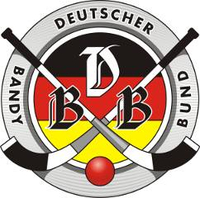
American Bandy Association
Webside: https://www.usabandy.com/
Canada Bandy
Morris Glimcher
PresidentThis email address is being protected from spambots. You need JavaScript enabled to view it.
Mailing address
17-30 Victor Lewis Drive
WINNIPEG, Manitoba
Canada
R3P 1H5
Webside: http://www.canadabandy.caHungarian Bandy Federation
2011.05.29. Vasárnap 21:00 - 22:30, Gyakorló
A pályák címe: 1146 Budapest, XIV. ker., Istvánmezei u. 3-5. (Kisstadion, Millenáris, Gyakorló)
Webside: http://www.bandy.hu/
Norges Bandyforbund
Webside: https://bandyforbundet.no/?p=97&mID=71&mAct=0
Svenska Bandyförbundet
Webside: https://www.svenskbandy.se/
Address: Idrottens Hus, Skansbrogatan 7, Stockholm
Leveranser och Företagspaket: Östgötagatan 98 D, 116 64 Stockholm
Telefon: 08-699 6000 (växel), direktnummer nedan
Bankgiro: 713-20 61
Organisationsnummer: 818500-2733
Email:This email address is being protected from spambots. You need JavaScript enabled to view it. 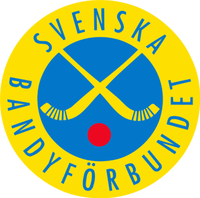
Українська федерація
Webside: http://www.ukrbandy.org.ua/
Адреса:49081, м. Дніпропетровськ, вул. Артельна, 2/304.
Телефон:+358401870360
Fb: https://www.facebook.com/groups/ukrbandy/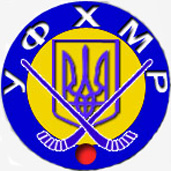
Great Britain Bandy Association
Webside: http://www.gbbandyfederation.uk/home-page
Fb: https://www.facebook.com/greatbritainbandyassociation/Czech Association of Bandy
Fb: https://www.facebook.com/czechbandy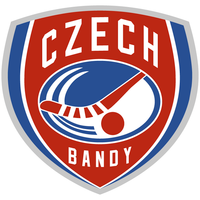
China Bandy Federation

Bandy Polska
Fb: https://www.facebook.com/BandyPolska/Slovak Bandy
Fb: https://www.facebook.com/Slovak-Bandy-642621149275457/?eid=ARADQC7depbKTKRvTRJvmXQTVyq1oLMqpPBAlHHCCAeABBFrDvgvqrep6DuotYTQUioZxeWVQfUtKu3C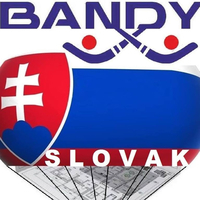
Swiss Bandy
Fb: https://www.facebook.com/swissbandy/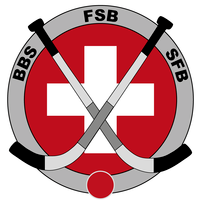
Федерация хоккея с мячом России, ФХМР (FKhMR)
105064, Москва, ул. Казакова, д. 27, оф. VI
Тел./факс: (499) 265-32-45
Webside: http://www.rusbandy.ru/
Fb: https://www.facebook.com/rusbandyru/
Wk: https://vk.com/rusbandy_ru
Twitter: https://twitter.com/rusbandy
Youtube: https://www.youtube.com/user/Rusbandy
Instagram: https://www.instagram.com/rusbandy/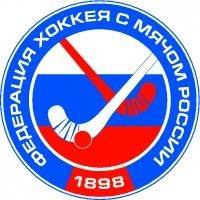
Bandy Association of Indian
Fb: https://www.facebook.com/1282168178474486/photos/a.1282169238474380/1300584519966185/?type=3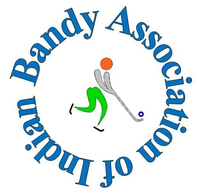
- Sources of information :
Books:
Arlott, John, ed. (1975). "Bandy". The Oxford Companion to Sports & Games. Oxford: Oxford University Press.
Arne Argus: "Bandy i 100 år", 2002, ISBN 91-631-3005-X, p. 36 (in Swedish)Articles:
https://www.nytimes.com/2010/01/29/sports/olympics/29bandy.html
Bandy in Finland - http://www.finbandy.fi/fi/yhteystiedot/the-finnish-bandy-federation-in-english/
https://thehockeywriters.com/bandy-the-other-ice-hockey/
https://cafebabel.com/en/article/bandy-ice-hockey-in-sweden-goes-big-in-europe-5ae00544f723b35a145ddc05/
https://www.thelocal.se/20160229/bandy-how-swedens-little-known-sport-is-winning-convertsVideos:
https://www.youtube.com/watch?v=yIl9B_L9y6I
https://www.youtube.com/watch?v=KUaxDB0ea3M
https://www.youtube.com/watch?v=3LHSMaHVy5I
https://www.youtube.com/watch?v=ZEhcFvFw9v0
https://www.youtube.com/watch?v=RN0PeNnwyqA - Gallery:
- Documents:
- Name of sport (game): Baranta
- Name in native language: Baranta
- Place of practice (continent, state, nation):
Hungary
- History:
The word Baranta has remained mainly in those western and southern parts of Hungary where the population had always been Hungarian (Somogy, Ormánság, Göcsej, Őrség). In literature the most often we can find it the artworks of János Kodolányi. The meaning of the word is competing with weapons, challenge, training for a fight or a battle, legaly applied violence or applying force. Between some Kaukazian peoples it refers to the place for armed practices, and according to the oldest written sources it means ’warriors of the Sun’ and ’the men who allied with the Sun’. Baranta communities in East-Turkestan (land of the ujgur people) had been working as martial artist groups until interference of chinese authorities.
According to the habbit that has remained near Somogyvár the people who practised Baranta were the oathed, specially trained helpers of the judge of the old tribe-union (Horka) who protected the ancient laws. These warriors, beside the special skills in fighting and using their weapons, cultivated the highest levels of moral values.
In the case of Baranta consistency is given by the organic Hungarian culture, which provides a straight heritage with its’ social sructure and intellectual elements. These informations, about the training and personality-forming methods of these warrior communities that had great fighting knowledge, has been available from at least 1300 years all in all.
In the case of Hungary it can be observed that Hungarian social groups had to fulfill the tasks of self-defense, farming, and sacrality in the same time. ’Preparing’ the members of the community was a basic task in the society. The so-called ’Baranta-skills’ had been being restricted for about 5OO years with different laws, orders and local regulations. The most elements of motion were saved in fight- and weapon-dances (woodstick). The ethnograhic studies revealed that these elements were the ’school-practise’ for the real fighting skills. The motions usually followed more the rules of a fight than the rhytm of the music. Since ’fight-dances’, the ancient emulations, the teaching of games and the preparation for weapon-practice seems to be a progression, the basic motions are being developed all the time, which means that Baranta has contents from really ancient times.
Baranta is basically not a model of a master’s collected motions and personality-forming methods, but it is the manifestation of a nation’s cultural effects in a fight that is working organically.
In the middle of the 19th century the world went through a ’revolution of body-culture’. As a result of this process the nowadays well-known sports, the combat-sports and a new system of fighting motions came into existence. Three basics ways of ’body-culture’ came off: the german type etatist gymnastics movement, the anglo-saxon ’gentlemen sports’ which lean on ancient greek origins, and the attemptions of raising folk-games, dances and fighting competitions into sports.
While in some countries of Asia, partially they managed to raise the martial arts and fighting forms into the modern sports-life as a ’folk-movement’, in Europe that has not happened.
In Hungary the competitions, games and dances of traditional ’folk body-culture’ were revived by the ’reform-ages’ and they were vitalized and mistificated in the ’defiance-ages’ of the autocracy. The founder of Hungarian Athletics Club (MAC) and cultural attaché of London, count Miksa Esterházy and his circle of friends in company with the elite of some rebellious towns attempted to create the independent ’body-culture’ leaning on Hungarian cultivation and literacy. In this campaign for saving the folk games and forms of fighting rivalry, from county-balls and national casinoes to lowland-festivals local guests wanted to demonstrate with their patriotism.
The games including fights with sticks, pocket knives, swords and wrestling soon faced the problems of the movements promoted from the top. In bigger cities where neccessary human and financial resources were available, the games looked out of place. In villages and towns however, people either missed the message or there were no people who could teach the in-depth knowledge of the collected moves. Movements founded in Békéscsaba, Tata, Nagykanizsa, Hódmezővásárhely, Kolozsvár, the outskirts of Budapest, rural areas of Sárospatak, Kisalföld and Székelyföld were short lived. Between 1848-1941 some parts of baranta appeared in the military rulebook. During 1928-1941 Hungarian military officials began the research of the (Hungarian) warrior moves which were used in the training of the newly formed special operation branch and paladin training.
„The Hungarian culture is an ongoing battle between tradition and western culture. Peace can only be achieved if the tradition becomes the dominant culture, only scalvaging and dissolving the neccessary European knowledge to do so....” Kodály 1939.
Baranta is, in fact the result of the fight for independent Hungarian body culture.
The reasearch was carried on by Ferenc Vukics at the Kossuth Lajos Military Academy in 1991, the organizational design was also formed around this time. - Description:
Baranta includes a wide range of fights. The curriculum varies from traditional long range weapons to hand-to-hand combat, from individual fights to military leadership, and organizational and leader knowledge of communities.
It consists of two branches, infantry and cavalry. Both branches compete in 10 unique competitions. Their most important weapons are: bow, saber, short and long stick, fustély (another type of stick), spear, lance, axe, shield, battle axe, longwhip, throwing star, knife. During hand-to hand combat it differentiates between cultical wrestling (belt-wrestling) and a special type which includes kicks and punches, the so called fight wrestling (böllön). The cavalry branch demands a cooperation with the horse to the extent where it can be controlled and used in battle without any equipment or whatsoever.
The cummunal discipline and proper education is a key element to Baranta. - Current status:
Baranta is a continuously developing martial art, which has been created by collecting all the movements from Hungarian body-culture, fighting and battling techniques that had been applied during our history. It is based on the knowledge of folk-culture and a still shaping independent philosophical tendency of Hungarian origin called ’social psychology’ or ’folk psychology’ (one of its founder and most quoted writer is Sándor Karácsony).
At the moment, in six countries, in more than a hundred communities, about 2500 people are practising the style based on the traditional hungarian values, moral and culture of motion. - Importance (for practitioners, communities etc.):
„There is no other nation which would ridicule the order and ordinatia than the Hungarian, even though there isn't any which would need it more...” Mikós Zrínyi
The people who practice Baranta continously grows not only in the motherland but areas traditionally populated by Hungarians. Significant Baranta centres were opened in Székelyföld (Transylvania) and Felvidék (Southern part of Slovakia), which are part of the Hungarian Martial Arts Allience since 2005.
Communities who were actively involved in research for culture, arts, and lifestyle strongly influenced the social life of the country. They have their own independent colleges, community all around the country. They don't accept government foundings, their communities are build and operated by creative forces. They don't accept the traditional and non-traditional thesises of the western philosophies. In their opinion the Hungarian folk traditions show eastern signs. The tradition is the ever developing showcase of experience about life. It has to represent the work of every generation.
„Truth be told, it is a lifestyle where the first and most important person is the community, with unchanged spirit, only the fathers and sons changing roles.” Áron Tamási
„...being Hungarian is not about race nor blood, but spirit. It was not the blood that created the Hungarian soul and thus also creating the Hungarian race, on the contrary, it was the Hungarian soul that influenced the blood and this is the Hungarian race, now and any time, imbued by the Hungarian spirit. Everyone is only Hungarian to the extent to how strongly does the Hungarian soul live inside and act through him..” Sándor Karácsony 1938
„ The nation is but a group of people sharing the same language, religion, and love bound together by their aspect of future...” Vukics 1998
„Tradition is the science of life” Vukics 1998
„ Everyone is part of the nation who lived before us, working for us, everyone in the present who try to build and everyone in the future who will born - thanks to these. We have to fight our battles in the present for the values which we stand for. We have to revise our knowledge by our experience, and we have to give an ever growing and developing world to the next generation... „Vukics 2001
And because of this they are not connected to parts of history, they consider it as a process of learning. Their symbols are the Hungarian line of flags, and the Turul bird of Rakamaz. According to them the Hungarian literac and body culture includes enough values so that people of other nation would like to learn it. As of now Baranta is not only practised by Hungarians but by the younger generation of some Germans and Japanese. - Contacts:
Baranta Traditional Hungarian Martial Arts Association
Email:This email address is being protected from spambots. You need JavaScript enabled to view it.
www.facebook.com/baranta.szovetseg/
www.youtube.com/OrszagosBarantaSovetseg
www.instagram.com/barantamartialart
- Sources of information :
Source of photos used in this article and gallery: Baranta Traditional Hungarian Martial Arts Association
- Gallery:
- Name of sport (game): Bat and Trap
- Name in native language: Bat and Trap
- Place of practice (continent, state, nation):
United Kingdom
- History:
Stoolball is an ancestor of cricket and bat and trap and play is pretty similar to cricket. The story goes that milkmaids started the game by throwing stones at their upturned stools while waiting for their shepherd husbands to return from the fields where they were passing the time throwing stones at “wicket gates”, a kind of field gate. A more concrete fact is that the game, in 1671, was apparently played in North Wiltshire, North Gloucestershire and near Bath. At that time the ball was 4 1/2 inches (11.43cm), stuffed with quills and very hard. The bat was a “staffe” made of withy about 3 1/2 feet (1.0668m) long. It seemed to die out after the 17th century but in 1916 Major Grantham of Balneath Manor, Sussex re-kindled it as a healthy pastime for convalescing soldiers and it has been alive ever since.
When the enthusiasts of Bat and Trap opened their new league season in May 2011 they were celebrating the 89th anniversary of the Canterbury League’s foundation. It was in May 1922 that the first round of League matches were played in the city of Canterbury, Kent. The game is undoubtedly ancient, and the earliest evidence of some such game is said to be contained in a drawing in a monastic manuscript of the 13th century, showing a monk playing a similar game. However, this manuscript has not been seen by Brin Tyndall, Andrew Wayre or Peter Guise of the Canterbury Bat & Trap League who kindly provided a substantial amount of this historic information. It is not possible to state that the game was devised at a particular time by a particular individual. Its’ origins are most surely lost in the mists of time. It is extraordinary, though, that this game was created, reputedly a forerunner of cricket, in which no-one actually had to run anywhere! The equipment used by modern players may all be made of wood by any decent carpenter, as it surely was then.
Source: https://www.batandtrap.org.uk/history/ - Description:
Each team consists of six players – fewer can play but the depelted side has to give away a free run in place of the missing player every sixth bowl.
Once the two Captains of the teams have decided the order of play by tossing a coin – one team bats and the other bowls.
The first of the six batsmen will then walk to the trap and place the ball on it. All of the opposing team will stand on the line between the posts to bowl or even attempt to catch the ball. The batsman then strikes the back of the trap with the bat. As the ball raises the batsman attempts to hit it between the posts.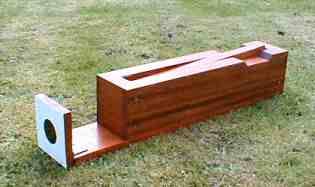
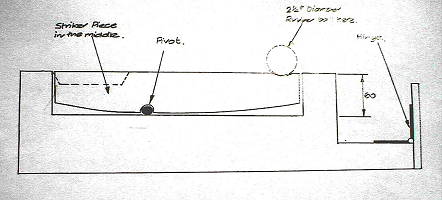
There are primarily two methods adopted by batsmen to hit the ball – either from the side or behind the trap.01 Side Batting 1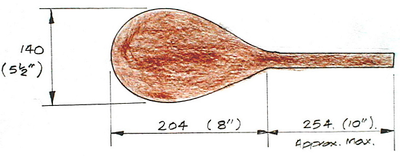
The batsman is allowed to strike the trap twice without hitting the ball. However, should the batsman strick at the ball a third time and miss then he is out.
I the batsman fails to hit the ball between the posts then he is out. If a fielder catches the ball the batsman is out, with the following provisos: The catcher must have one foot touching the ground on or behind the line, and the ball must be caught in front of the line. A batsman striking the ball more than seven feet high at the bowler’s end even if it’s between the posts shall be out.
The batsman having struck the ball between the posts shall then stand well clear of the trap (but not behind it) until the ball is bowled back.
No bowler shall bowl more than one ball in six. All bowlers shall bowl in batting order. The bowler must have one foot behind the line and on the ground when bowling. Bowling shall be underarm only.
If the bowler knocks down the flap the batsman is out. The batsman must not touch the ball before it reaches the trap. One run is scored if the ball is hit between the posts and the bowler fails to knock down the flat.
The fielding team must remain on the field during the innings. In the event of the ‘No Ball’ a rund shall be scored and the batsman cannot be bowled out. The player bowling the ‘No Ball’ will not bowl again until his next turn.
The process of batting and rotated bowling continues until all the batsmen are out. The teams then rotate and the process is repeated. The team with the highest number of runs wins the leg. A match will consist of the best of three legs with all three being played. Captains will toss a coin for choice of play before commencing each leg.
Source: https://www.batandtrap.org.uk/basic-playing-rules/ - Current status:
Practiced. It is still played in Kent, and occasionally in Brighton.
- Contacts:
Canterbury & District Bat & Trap League
Webside: http://www.batandtrapleague-canterbury.uk/
Fb: https://www.facebook.com/groups/canterburybatandtrap/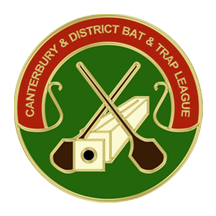
East Kent Friendly Bat and Trap
Webside: http://www.batandtrap.co.uk/ - Sources of information :
Articles:
http://www.roundhill.org.uk/main.php?sec=history&p=The_real_Bat_and_BallVideo:
https://www.youtube.com/watch?v=gLSY6t8Of7s
https://www.youtube.com/watch?v=fV8Bk64YaXo
https://www.bbc.com/news/av/uk-england-40820448/learning-how-to-play-bat-and-trap - Gallery:
- Documents:
- Name of sport (game): Bataireacht
- Name in native language: Bataireacht, also known Bata, Boiscín, Irish stick-fighting
- Place of practice (continent, state, nation):
Ireland
- Name of sport (game): Beltescast
- Place of practice (continent, state, nation):
Sweden
- Name of sport (game): Birlos, Birla
- Name in native language: Birlos, Birla
- Place of practice (continent, state, nation):
It is played throughout Aragon, from the Pyrenees to Rubielos de Mora.
It can be played individually or in teams.
In some places, such as Campo Y Benasque (Huesca) it is exclusively a women's game. - History:
This is a traditional game, of Celtic origin, that was played in the streets of the towns of Aragon and Spain, with variations in the rules and name, depending on the region. It is a very good example of a street game.
- Description:
As in other parts, the game consists of placing nine straight pins on the ground and each player knocking down as many as he can by throwing from a line marked on the ground.
In the Pyrenees the throwing ball has a handle, while in other parts it is smooth and generally smaller.
Game elements have different names. BIRLOS, BIRLA, the one that has the most value. HANDLE, is the piece that is used to pull the BIRLOS.
They are placed at a distance of 10 meters. Each BIRLO is worth 1 point and the BIRLA is worth 5 points. It is launched with the TIRADERA. You can play individually, one against one; or in pairs. The number of runs is agreed upon and at the end, the one with the most points is the champion.
In Huesca and Zaragoza, billas are sticks with turned heads. In other places they are called birlos, and in Monreal del Campo, bolos and bolinches. - Current status:
Practiced
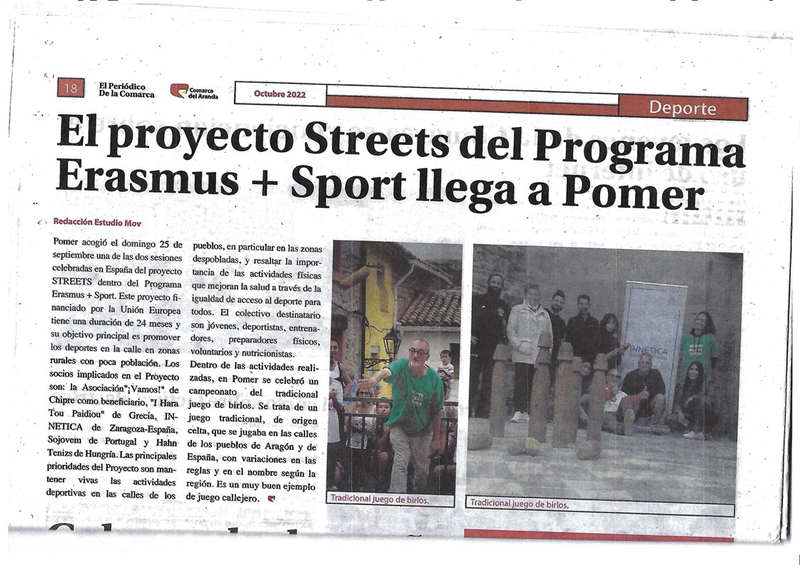
- Sources of information :
Articles:
https://identidadaragonesa.wordpress.com/2017/06/20/los-juegos-de-bolos-en-aragon/
https://www.heraldo.es/noticias/aragon/2017/05/24/deportes-aragoneses-una-tradicion-que-mucho-juego-1177276-300.htmlThe information contained in the article comes from the following sources:
Informations from Antonio HornoSource of photos used in this article and gallery:
photo Antonio Horno
https://twitter.com/PyrenePV/status/561100902724304897 - Gallery:
- Name of sport (game): Bocce
- Name in native language: Bocce
- Place of practice (continent, state, nation):
Italy
- Contacts:
Bocce Standards Association
https://www.boccestandardsassociation.org/ - Sources of information :
Articles:
https://www.orderisda.org/culture/sports/italian-sport-the-history-of-italys-second-favorite-sport-bocce-ball/
https://www.worldbocce.org/bocce-history.htmlVideo:
https://www.youtube.com/watch?v=v3slD-qDIW8&t=199s
https://www.youtube.com/watch?v=_bJx_BmgvzI
https://www.youtube.com/watch?v=wmQVO2a9ZEI

